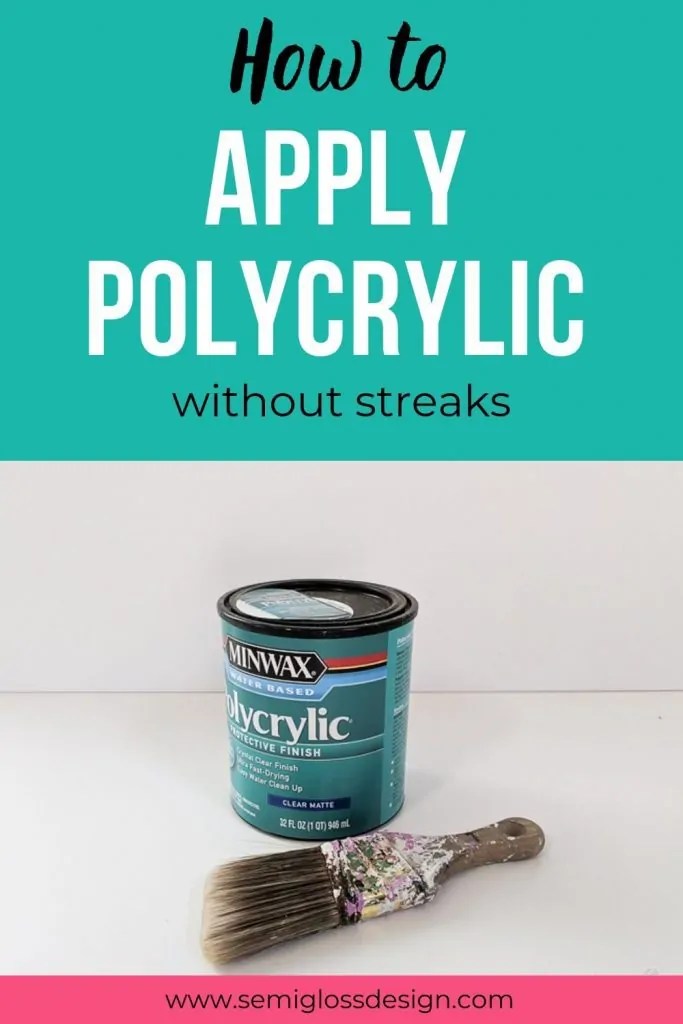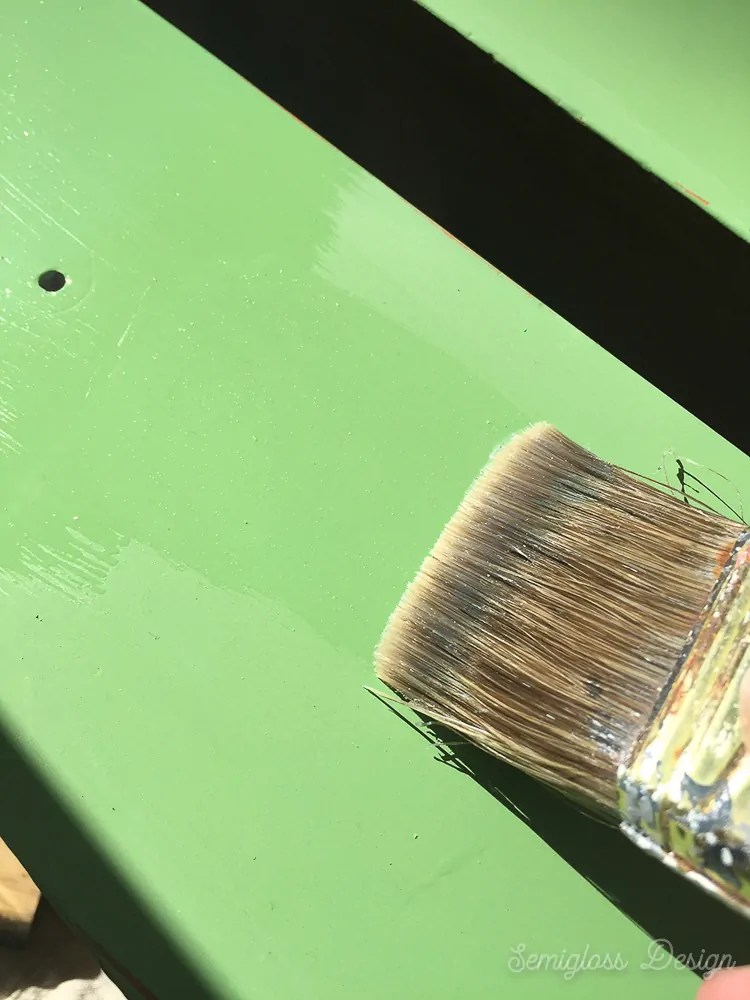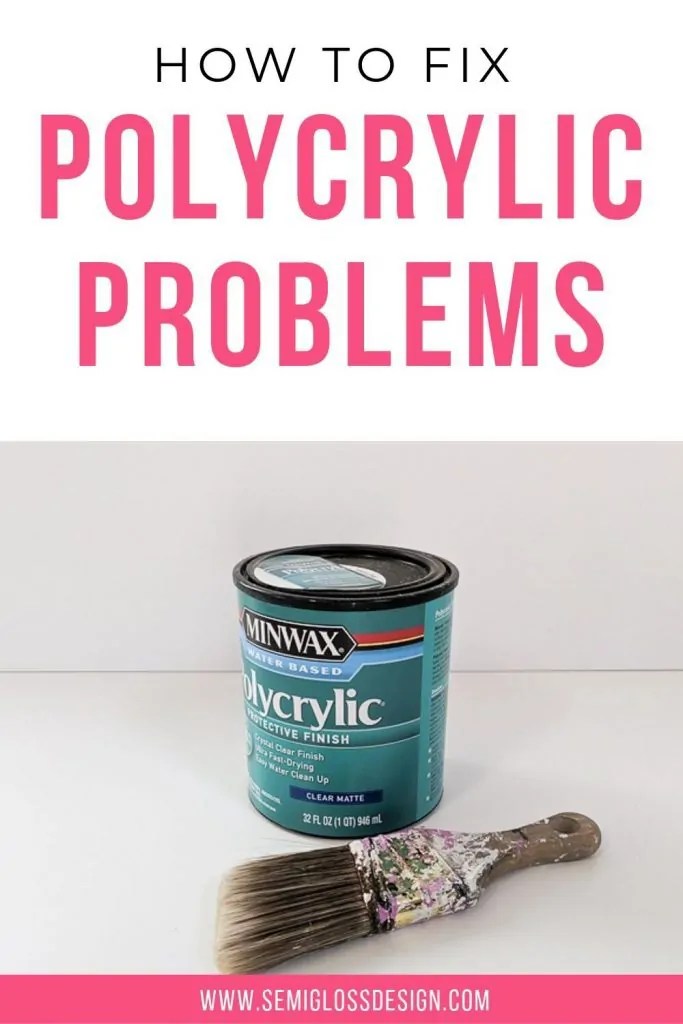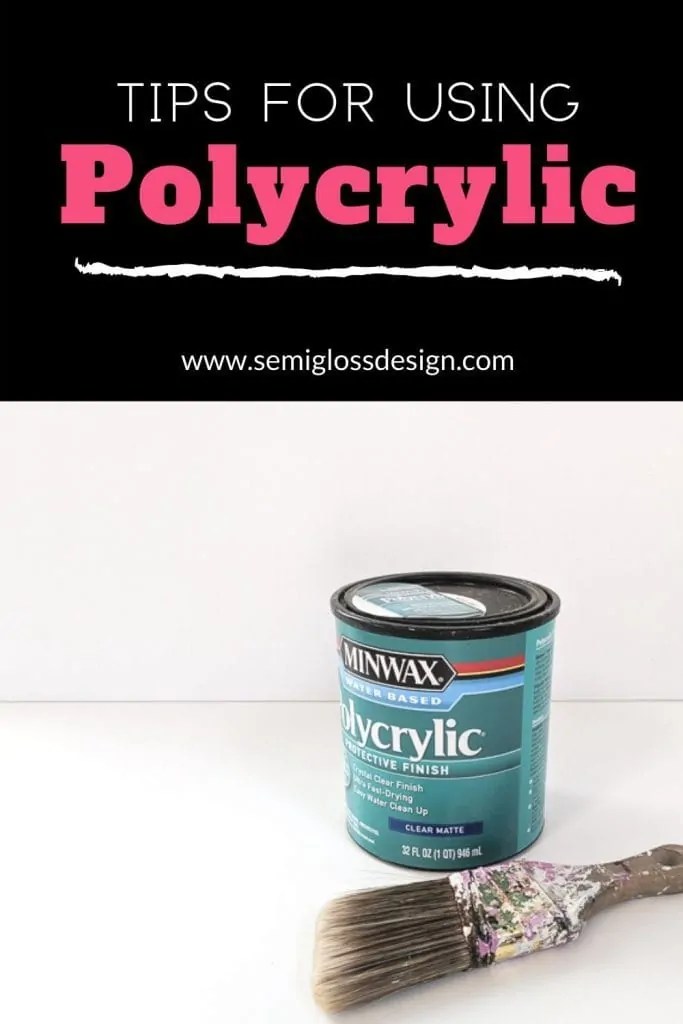Learn how to apply polycrylic without streaks. There’s nothing worse than spending hours painting a piece of furniture, only to feel like you’ve messed up the topcoat.
I’m sharing my tips and tricks for avoiding brush strokes and bubbles, plus how to fix them if they occur.
You might be interested in this post on refinishing a tabletop.

This post contains affiliate links. By purchasing an item through an affiliate link, I earn a small commission at no extra cost to you. As an Amazon Associate I earn from qualifying purchases.
Polycrylic is my favorite top coat when painting furniture for many reasons.
Polycrylic is pretty easy to use, easy to find in stores, inexpensive, easy to clean up (water-based), and most importantly: polycrylic doesn’t yellow over white paint or light colors!
How to Apply Polycrylic without Streaks, Brush Strokes or Bubbles
How to Avoid Brush Strokes and Streaks
Keep a wet edge. This means only touch wet paint that you’ve just painted.
Touching paint that has sat for even a few minutes can cause streaks. It picks up what you’ve already painted and drags it a bit.
Instead, skip that part and get it in the next coat. You won’t be able to see it when you’re finished.

Use a good brush. I prefer this brush for painting polycrylic.
The soft bristles minimize brush strokes, but it’s still large enough to get good coverage.
Pro tip: I store my brushes in plastic baggies between coats to make sure that the paint doesn’t dry on the bristles. Just keep in mind that the longer you leave the brush in the bag, the harder it will be to clean.
Paint in one direction. Only paint in one direction so that you don’t accidentally touch an area where you already painted.

Use a new can of polycrylic. Polycrylic only lasts so long before it gets too thick to use. For this reason, I prefer buying smaller cans.
A tightly sealed paint container should last about a year, especially if the can is full.
When the can starts getting empty, the consistency starts to change and it gets harder to work with.
Avoid painting in humid weather. Although polycrylic does better than any other topcoat in humidity, it makes your job so much harder because it takes forever to dry.
If you can’t avoid painting in humid weather, give it plenty of time to dry between coats, and don’t paint over wet spots.
Use thinner coats. Thinner coats of paint dry faster. Thicker coats are more likely to end up with drips.
Use a matte finish. Shiny finishes show more flaws. A matte finish will minimize any flaws.
Sponge application. I’ve had mixed results with this technique, but I thought I would share it.
You can wear gloves to avoid getting polycrylic on your hands, but I’ve found that it’s easy to clean up with soap and water.
Dense sponges work better. A cheap sponge may cause bubbles!

- Wet the sponge.
- Dip it into the polycrylic can.
- Wipe it on the surface slowly.
- Avoid touching previously wet places.
- Let dry and apply more coats for full coverage.
How to Avoid Bubbles
Do not shake the can. Gently stir it to mix the contents so that you don’t work air into the mixture.
Don’t use a roller. Rollers can cause bubbles and other textures.
Use a good brush. A cheap brush (like a foam brush) is likely to cause bubbles.
Paint slowly. Sometimes bubbles form from painting too quickly.

How to Correct Streaks or Bubbles
- Let the polycrylic dry completely.
- Sand lightly to remove the texture.
- Reapply polycrylic using the tips above. Remember to not touch wet paint!
Polycrylic FAQ’s

Can polycrylic be rolled on?
In most cases, I don’t suggest rolling polycrylic. On furniture, a foam roller will produce an undesirable, bubbled texture.
Brush or spray it on for best results.
How many coats of polycrylic should you apply?
Apply 2-3 coats of polycrylic to create a long-lasting finish.
For surfaces that receive a lot of wear and tear (like a tabletop or a floor), you might want to apply 4 or even 5 coats.
How long should the paint dry before applying polycrylic?
It depends on the humidity levels and temperatures. Most paint dries in about 2 hours. Allow more time on humid days.
Polycrylic needs to dry for several hours between coats.
How long should you wait between coats of polycrylic?
The time between coats will depend on the humidity level and temperature. Days with high humidity will result in longer drying times.
On a normal day, I normally wait 30 minutes to 1 hour before applying another coat.
Will polycrylic yellow over time?
No. This is one of my favorite features about polycrylic.
If you are seeing yellow, it’s not caused by the polycrylic. It’s caused by tannins that have bled through the wood.
Click here to read a post on how to seal tannins when painting white furniture.
What’s the difference between polycrylic and polyurethane?
Polycrylic is water-based, so it’s easy to clean up, dries fast, and doesn’t smell bad. It also doesn’t yellow over time.
Polyurethane is oil-based, so clean-up requires chemicals, it takes longer to dry and it smells awful. It DOES yellow over time.
Do you have to sand between coats of polycrylic?
Yes and no.
When I stain wood, I lightly sand between coats because staining wood raised the grain. Sanding smooths it out and allows you to get a buttery soft finish.
Paint doesn’t raise the grain of the wood, so I typically do not sand between coats of polycrylic over paint.
However, if it feels rough to the touch after a coat of polycrylic, you can sand it with 400 grit sandpaper to make it smooth.
Make sure you clean the surface after sanding.
How do you clean polycrylic off a paintbrush?
Run the brush under water until the water runs clear. Polycrylic is clear, but the water will be slightly milky while rinsing the brush.
Wash the brush longer than you think. Since polycrylic is clear, it can be harder to get it all out.
When I use polycrylic, I usually clean it with a bit of dish soap as well. Since it takes longer to rinse soap bubbles, it’s a good way to ensure that you’ve rinsed the brush for long enough.
For best results, use a brush cleaner to ensure that the brush is completely clean. Brush cleaners also help keep your brushes in good condition.
If your brush dries with polycrylic, it’s still possible to rescue the dried brush using these tips.
You might also like:
- The Best Primer for Furniture
- How to Clean Furniture Before Painting
- The Ultimate Guide to Painting Furniture
Pin for Later!


